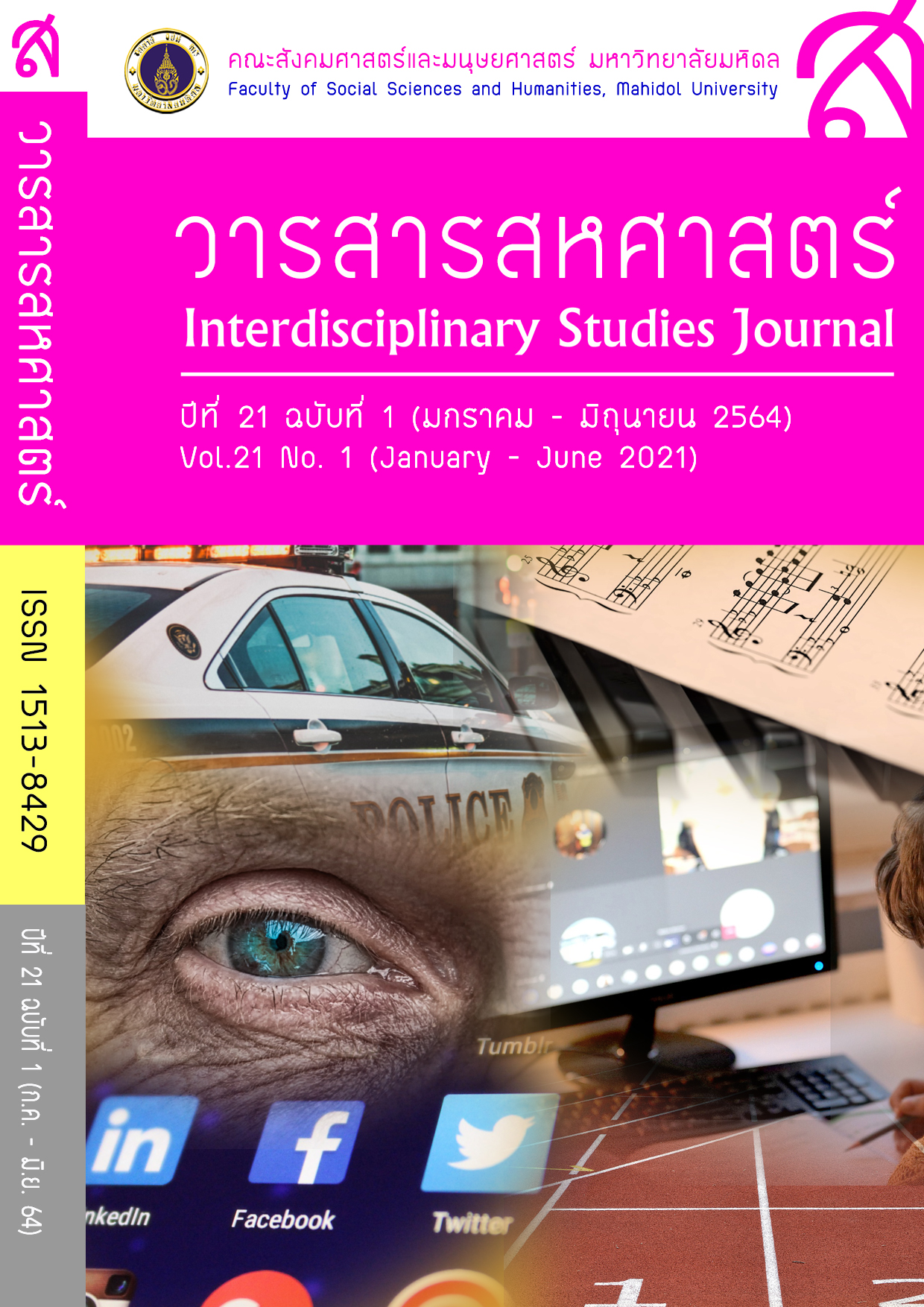การรู้เท่าทันสื่อดิทัลของผู้สูงอายุ
คำสำคัญ:
ผู้สูงอายุ/ ปัจจัยด้านบุคล/ ปัจจัยด้านสิ่งแวดล้อม/ สื่อดิจิทัลบทคัดย่อ
การวิจัยนี้ มีวัตถุประสงค์ คือ 1.) ศึกษาการรู้เท่าทันสื่อดิจิทัลของผู้สูงอายุในกรุงเทพมหานครและปริมณฑล 2.) เปรียบเทียบความแตกต่างระหว่างปัจจัยด้านบุคคล กับการรู้เท่าทันสื่อดิจิทัลของผู้สูงอายุในกรุงเทพมหานครและปริมณฑล 3)เปรียบเทียบความความแตกต่างระหว่างปัจจัยด้านสิ่งแวดล้อมของผู้สูงอายุกับการรู้เท่าทันสื่อดิจิทัล 4) หาความสัมพันธ์ระหว่างปัจจัยด้านสิ่งแวดล้อม กับการรู้เท่าทันสื่อดิจิทัลของผู้สูงอายุในกรุงเทพมหานครและปริมณฑล โดยใช้ระเบียบวิจัยเชิงปริมาณ โดยใช้สถิติเชิงพรรณนา(Descriptive Statistics) และสถิติเชิงอ้างอิง (Inference Statistics)เพื่อทดสอบสมมติฐาน ผลการวิจัยพบว่า 1) ปัจจัยด้านบุคคล พบว่า ผู้สูงอายุที่มีอายุ เพศ และระดับการศึกษาที่แตกต่างกันจะส่งผลให้รู้เท่าทันสื่อดิจิทัลได้แตกต่างกัน 2) ผู้สูงอายุที่มีปริมาณการใช้งานสื่อดิจิทัลที่แตกต่างกันจะมีการรู้เท่าทันสื่อดิจิทัลที่แตกต่างกันอยู่ 2 ด้าน ได้แก่ ด้านความสามารถในการเข้าถึงสื่อดิจิทัล และด้านความสามารถในการทำความเข้าใจในเนื้อหาของสื่อดิจิทัล และผู้สูงอายุที่มีปริมาณการใช้งานสื่อดิจิทัลที่แตกต่างกันจะไม่มีการรู้เท่าทันสื่อดิจิทัลที่แตกต่างกันอยู่ 2 ด้านคือ ในด้านความสามารถในการวิเคราะห์และประเมิน และการมีปฏิสัมพันธ์อย่างปลอดภัยต่อเนื้อหา 3) เมื่อผู้สูงอายุมีการแลกเปลี่ยนข้อมูลข่าวสารในเรื่องสื่อดิจิทัลกับครอบครัวผู้สูงอายุจะสามารถเข้าถึงสื่อชนิดต่าง ๆได้จากการสอบถามสมาชิกในครอบครัวรวมถึงสามารถทำความเข้าใจในเนื้อหาของสื่อนั้น ๆได้ 4) หากผู้สูงอายุที่มีการเปิดรับสารสนเทศด้วยความถี่มากก็จะมีความสามารถในการรู้เท่าทันสื่อดิจิทัลด้านความสามารถในการเข้าถึงสื่อดิจิทัลมากตามไปด้วย
เอกสารอ้างอิง
ขวัญฤทัย สายประดิษฐ์. (2551). บทบาทนักประชาสัมพันธ์กบการประชาสัมพันธ์ในสื่อใหม่ตอน ที่1.พัฒนาเทคนิคศึกษา, 20(65), 42-51.
ชมพูนุท พรหมภักดิ์. (2556). การเข้าสู่สังคมผู้สงอายุของประเทศไทย, 27 มกราคม 2561. http://library.senate.go.th/document/Ext6078/6078440_0002.PDF
นภินทร ศิริไทย. (2547). “ความรู้เรื่องการรู้เท่าทันสื่อเพื่อสุขภาพภูมคุ้มกันที่ดีสำหรับเด็กและเยาวชน”ในการพัฒนาองค์ความรู้การรู้เท่าทันสื่อสุขภาพสู่หลักสูตรในระบบและนอกระบบการศึกษาของไทย. กรุงเทพมหานคร: สำนักงานกองทุนสนับสนุนการสร้างเสริมสุขภาพ.
พนม คลี่ฉายา. (2556). การรู้เท่าทันสื่อมวลชนกระแสหลักของคนกรุงเทพมหานคร.รายงานการวิจัยจุฬาลงกรณ์มหาวิทยาลัย, คณะนิเทศศาสตร์.
พวงทอง ไกรพิบูลย์. (2557). ผู้สูงอายุ (Older person), 27 มกราคม 2561.http://haamor.com/th
พิศิษฐ ตณฑวณิช. 2543. สถิติเพื่องานวิจัยทางการศึกษา. กรุงเทพฯ : เธริดเวฟ เอดด็ ูเคชั่น.
อารีย์ เพชรหวน. (2553). "ห้องสมุดระดับอุดมศึกษากับการรู้สารสนเทศ." วารสารวิชาการ วิทยาลัยเซาธ์อีสท์ บางกอก. 7, 10 (มกราคม - มิถุนายน): 34 - 42.
รักจิต มั่นพลศรี. (2547). Media Literacy: ศาสตร์แห่งการเปิดรับสื่อด้วยปัญญา. วารสารวิชาการมหาวิทยาลัยวงษ์ชวลิตกุล. (2): 67-83.
สรานนท์ อินทนนท์. (2562). “การบริหารจัดการเวลาบนโลกดิจิทัล.”กรุงเทพฯ: มูลนิธิส่งเสริมสื่อเด็กและเยาวชน. นครปฐม: สถาบันวิจัยประชากรและสังคม มหาวิทยาลัยมหิดล.
มูลนิธิสถาบันวิจัยและพัฒนาผู้สูงอายุไทย. (2561). “สถานการณ์ผู้สูงอายุไทย พ.ศ. 2561.”
วัทนีจันทร์โอกุล. (2550). รายงานการวิจัยความต้องการการพัฒนาคุณภาพชีวิตของผู้สูงอายุ ในชุมชนเมืองในสังคมยุคแห่งการเรียนรู้.จาก htllp://www. Thaingo.org/writer/ view.php?id=1425.
สถาบันวิจัยและให้คำปรึกษาแห่งมหาวิทยาลัยธรรมศาสตร์. (2558). กรอบแนวทางในการจัดทำแผนยุทธศาสตร์การพัฒนาคุณภาพชีวิตและการเรียนรู้ของผู้สูงอายุ ในยุคหลอมรวมเทคโนโลยี, https://btfp.nbtc.go.th/sites/default/files/file-portfolio
สุทธิชัย จิตะพันธ์กุล. (2545). มโนทัศน์ของวัยผู้สูงอายุในประเทศไทย รายงานการทบทวนองค์ความรู้และสถานการณ์ในปัจจุบันตลอดจนข้อเสนอแนะทางนโยบายและการวิจัย.รายงานการวิจัย, สำนักงานกองทุนสนับสนุนการวิจัย (สกว.).
อดุลย์ เพียรรุ่งโรจน์. (2543). การศึกษาแนวคิดเพื่อกำหนดตัวแปรความรู้เท่าทันสื่อสำหรับการวิจัยสื่อสารมวลชน.
อุษา บิ้กกิ้นส. (2554). การรู้เท่าทันสื่อและสารสนเทศ.นิเทศศาสตร์มหาบัณฑิต. มหาวิทยาลัยธุรกิจบัณฑิตย.
American Library Association.(2012). Digital literacy, libraries, and public policy. Retrieved 5 January 2018, from http://www.districtdispatch.org/ wp-content/ uploads/ 2013/01/2012_OITP_digilitreport_1_22_13.pdf
Buckingham, D. (2005). Constructing the media competent child: Media literacy and regulatory policy in the UK.MedienPädagogik, 5(2), 05-1.
Buckingham, D. (2008). Defining Digital Literacy-What Do Young People Need to Know About Digital Media? in C. Lankshear, & M. Knobel, M. (eds.). Digital Literacies: concepts, policies and practices. (pp. 73-88). Peter Lang, New York, NY
Baran, S.J. (2002).Introduction to Mass Communication: Media Literacy and Culture. USA:Mcgraw Hill.
Doyle, C. (1992). Development of a Model of Information Literacy Outcome Measures within National Education Goals of 1990 (Education Policy).Thesis (ED.D.) Northern Arizona University. Retrieved October 16, 2017 from http://www.uni. net.th/dao/detail.nsp
Hobbs, R. (2010). Digital and media literacy: A plan of action (knight commission on the information needs of communities in a democracy).Washington, DC: Aspen Institute & Knight Foundation. Harwood, J. (2007) Undrstanding Communication and Aging, Sage Pubilcations.
Jacobson, Jenna, Lin, Chang. & McEwen, Rhonda.(2016 under review). Aging with technology: Seniors and mobile connections. Canadian Journal of Communication.
Livingstone, S., Van Couvering, E., & Thumim, N. (2005). Adult media literacy: a review of the researchliterature. London, UK: Department of Media and Communications, London School of Economics and Political Science.
Martin, A., &Grudziecki, J. (2006).DigEuLit: Concepts and Tools for Digital Literacy Development.ITALICS: Innovations In Teaching & Learning In Information &
Mariska Kleemans. (2015). Understanding news: the impact of media literacy education on teenagers’ news literacy. Retrived December 12, 2017, from file:///C:/Users/Administrator/Downloads/JournalismEducationuittrekselGonnie.pdf. Computer Sciences, 5(4), 246-264. Masterman. (1985). Teaching the media. London: Routledge.
Morris, Anne. (2007). E-literacy and the grey digital divide: A review with recommendations. Journal of Information Literacy, 1(3), 13-28.
Murray, Meg Coffin, & Pérez, Jorge. (2014). Unraveling the digital literacy paradox: How higher education fails at the fourth literacy. Issues in Informing Science and Information Technology, 11(17), 85-100. Sonia. (2004). What is media literacy?, in http://eprints.lse.ac.uk/1027/1/What_is_media_literacy_(LSERO).pdf. Potter, W.J. (1998). Media Literacy.UK: Sage Publications.
Quan-Haase, Anabel, Martin, Ki, & Schreurs, Kathleen. (2014). Not all on the same page: Ebook adoption and technology exploration by seniors. Information Research, 19(2). URL: http://files.eric.ed.gov/fulltext/EJ1032691.pdf.
Steele, B. (2009). Digital literacy project teaches students the rules of the online academic world.Retrieved 5 January 2018, from http://www.news. cornell.edu/stories/ 2009/12/project-teaches-rules-online-academic-world
The United Nations Educational, Scientific and Cultural Organization (UNESCO). (2013). Global media and information literacy assessment framework: Country readiness and competencies. Paris, France: UNESCO. Retrieved October 21, 2017, from http://www. unesco.org/new/en/communication-and-information/resources/ publications-and-communication-materials/publications/full-list/ global-mediaand-information-literacy-assessment-framework/
The Partnership for 21st Century Skills.(2013). "Framework for 21st Century Learning." Retrieved October 21, 2017, from http://www.p21.org/overview.
UNESCO. (2011). Media and Information Literacy: Curriculum and Competency Framework. UNESCO, Paris.
UNESCO. (2006). Global Education Monitoring Report: Literacy for Life. Retrieved 5 January 2018, from http://unesdoc.unesco.org/images/0014/ 001416/141639e.pd

ดาวน์โหลด
เผยแพร่แล้ว
รูปแบบการอ้างอิง
ฉบับ
ประเภทบทความ
สัญญาอนุญาต
สหศาสตร์: วารสารสังคมศาสตร์และมนุษยศาสตร์ ให้ความสำคัญกับการคุ้มครองลิขสิทธิ์และสิทธิของผู้นิพนธ์ในการเผยแพร่ผลงานวิชาการ โดยมีวัตถุประสงค์เพื่อส่งเสริมความโปร่งใส ความถูกต้องตามหลักวิชาการ และสอดคล้องกับแนวปฏิบัติสากล ทั้งนี้ วารสารกำหนดนโยบายดังต่อไปนี้
|
1. การยอมรับเงื่อนไขการเผยแพร่ - ผู้นิพนธ์ที่ส่งบทความเพื่อตีพิมพ์ ต้องปฏิบัติตามนโยบายและเงื่อนไขการเผยแพร่ของวารสารโดยเคร่งครัด - การส่งบทความถือเป็นการยอมรับให้นำบทความเข้าสู่กระบวนการพิจารณาและการเผยแพร่ตามมาตรฐานของวารสาร |
|
2. การโอนลิขสิทธิ์ - เมื่อบทความได้รับการตอบรับเพื่อตีพิมพ์ ผู้เขียนโอนลิขสิทธิ์ของบทความให้แก่วารสาร - วารสารมีสิทธิ์เผยแพร่ ทำซ้ำ และเผยแพร่บทความในทุกรูปแบบ ทั้งสิ่งพิมพ์ เว็บไซต์ และสื่อออนไลน์อื่น ๆ |
|
3. สิทธิ์ของผู้นิพนธ์หลังการโอนลิขสิทธิ์ - ผู้นิพนธ์ยังคงมีสิทธิ์ใช้บทความเพื่อวัตถุประสงค์ทางวิชาการ เช่น การสอน การวิจัยส่วนบุคคล การใช้ประกอบวิทยานิพนธ์ หรือการเผยแพร่ในแพลตฟอร์มที่ไม่ใช่เชิงพาณิชย์ - การนำบทความไปใช้เพื่อวัตถุประสงค์เชิงพาณิชย์ ต้องได้รับอนุญาตจากวารสารก่อนเป็นลายลักษณ์อักษร |
|
4. การเผยแพร่ภายใต้สัญญาอนุญาตสาธารณะ (Creative Commons License) - บทความทั้งหมดในวารสารจะเผยแพร่ภายใต้สัญญาอนุญาต Creative Commons Attribution-NonCommercial-NoDerivatives 4.0 International (CC BY-NC-ND 4.0) - บุคคลอื่นสามารถเผยแพร่หรือแบ่งปันบทความได้โดยต้องให้เครดิตแก่ผู้นิพนธ์ต้นฉบับ แต่ห้ามแก้ไข ดัดแปลง หรือใช้ในเชิงพาณิชย์ |
|
5. ความถูกต้องของเนื้อหาและการใช้สื่อจากบุคคลที่สาม - ผู้เขียนต้องรับรองว่าบทความที่ส่งเพื่อตีพิมพ์เป็นผลงานต้นฉบับของตนเอง ไม่ได้ส่งซ้ำซ้อน (duplicate submission) และไม่ละเมิดลิขสิทธิ์หรือคัดลอกผลงานของผู้อื่น รวมถึงไม่มีการปลอมแปลงข้อมูล การตีพิมพ์ซ้ำ หรือการกระทำใด ๆ ที่ขัดต่อหลักจริยธรรมทางวิชาการ - ผู้เขียนต้องรับผิดชอบในการขออนุญาตใช้สื่อจากบุคคลที่สาม เช่น ภาพ ตาราง หรือกราฟิก และต้องอ้างอิงหรือให้เครดิตอย่างถูกต้องน |
|
6. ข้อจำกัดความรับผิดชอบ (Disclaimer) - บทความที่ได้รับการตีพิมพ์ในวารสารสหศาสตร์: วารสารสังคมศาสตร์และมนุษยศาสตร์ถือเป็นลิขสิทธิ์ของวารสาร - ข้อความ ข้อมูล และข้อคิดเห็นที่ปรากฏในบทความเป็นความรับผิดชอบของผู้เขียนแต่ละท่านโดยตรง มิได้สะท้อนถึงทัศนะหรือจุดยืนของกองบรรณาธิการหรือหน่วยงานที่เกี่ยวข้อง - หากบทความมีข้อผิดพลาดหรือการละเมิดสิทธิ์ใด ๆ ความรับผิดชอบทั้งหมดเป็นของผู้เขียนแต่เพียงผู้เดียว - การนำบทความไปใช้ในเชิงพาณิชย์ ต้องได้รับอนุญาตเป็นลายลักษณ์อักษรจากบรรณาธิการวารสารก่อน ทั้งนี้ ผู้ขออนุญาตต้องจัดทำคำชี้แจงเกี่ยวกับวัตถุประสงค์และลักษณะการใช้งานอย่างชัดเจน การใช้บทความในเชิงพาณิชย์โดยไม่ได้รับอนุญาตถือเป็นความรับผิดชอบของผู้ใช้แต่เพียงผู้เดียว |




